It is amazing how much Android software development has changed over the past 15 years. To help you keep up with all the changes to Android OS, we have created a brief history of Android software development.
By understanding the history of Android, you will know how to create successful mobile apps for the Android OS.
Android Name History
As it often happens in our lives, we get named after someone or something. Well, the Android name history started the same way back in 1989. It came from the nickname of one of the founders — Andy Rubin.
At the time when he worked at Apple, Rubin had a strong passion for Android robots. Henceforth, it was no surprise that Andy’s co-workers and mates began to call him Android — the name that eventually became official for the company and operating system.
Original Company
As with all histories, we start from the beginning. In 2003 Rich Miner, Nick Sears, Chris White, and Andy Rubin founded a company called, as we’ve already mentioned, Android Inc.
Rubin started Android so they could develop “smarter mobile devices that are more aware of its owner’s location and preferences”.
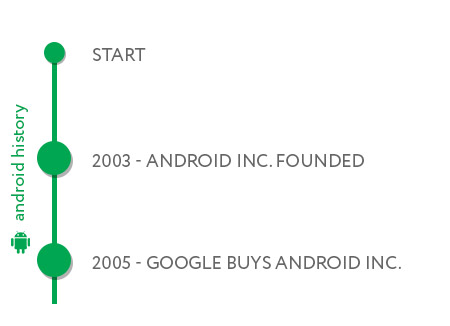
For the next two years the company struggled to gain a foothold in the smartphone industry. That was until Google purchased the company in 2005.
Rubin and his co-founders stayed on with full access to Google’s entire lineup of products.
One of the biggest decisions made at the time of the acquisition was to use Linux as the foundation for the Android operating system.
Launching and Open Source
Steve Jobs launched the modern smartphone era with his announcement of the iPhone on January 9, 2007. By June of that year, the first batch of iPhones was live in stores. The phone had become an instant sensation.
iPhone had become an instant sensation in June 2007
However, Google was not far behind. Then Google Chairman and CEO Eric Schmidt admitted in November 2007 to an ambitious new Google phone and an open source OS.

Google then joined the Open Handset Alliance with HTC, Motorola, Qualcomm, T-Mobile, and Texas Instruments. Later on, in September 2008, the first in the history of the Android device, HTC Dream, was launched onto the market and became commercially available.
Google’s Android OS became the de facto software for numerous smartphone manufacturing companies including HTC, Motorola, and Samsung.
The first Android phone was launched in September 2008.
The first Android-based smartphones were not as aesthetically pleasing as the iPhone. Still, many of them combined the new touchscreen technology with a physical QWERTY keyboard.
The first Android phone used several Google products such as Google Maps, YouTube, and Google search among others.


The Google Play store had not launched yet. Instead, they added the Android Marketplace where developers displayed their mobile apps.
Android Versions Evolution
Since that first phone in 2008, Google has launched 12 versions of their OS that is installed on over 3 billion of different devices.
They have also released five major Pixel phone models, which did not make a splash on the market despite an aggressive marketing campaign.
Here is the usage of multiple Android OS versions.
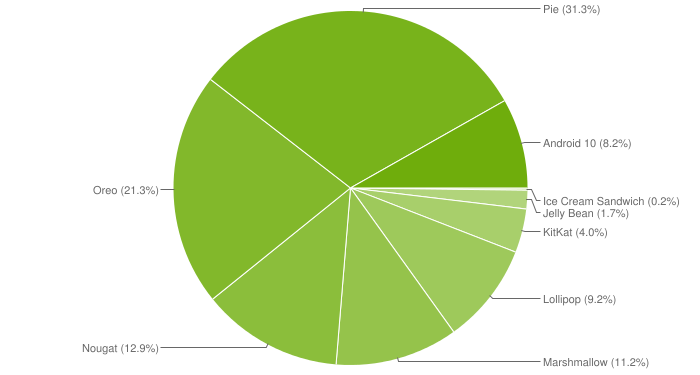
Source: Ausdroid
To some point, every version of OS was always named after sweet treats or desserts in alphabetical order. Google once explained: “Since these devices make our lives so sweet, each Android version is named after a dessert.”
However, starting from Android 10, iconic names went away, being replaced with simple numbers. In fact, it became hard to find an easy-recognizable dessert while you get towards the end of the alphabet.
So now let’s move to the Android versions list and take a look at each to explore how the operating system has actually evolved throughout the timeline.
Android 1.5 Cupcake

The first Android phone was running OS version 1.0 that was basic but had a set of Google apps like Gmail, Calendar, YouTube, and Maps. However, the real history of Android interface and functionality as we know it today started with Android 1.5 called Cupcake in April 2009.
It had essential improvements, including auto-rotation, video recording, and the first on-screen keyboard that replaced a physical one. It also introduced a search widget and the framework for the third-party app widgets, which provides a flexible and customized home screen.
Android 1.6 Donut
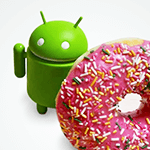
Shortly after the Cupcake, in September 2009, Android rolled out a new version — Donut. Most importantly, it involved support of the OS to work on a wide variety of screen sizes and resolutions.
Another new feature that set the ground for Android global expansion and imminent adoption by carriers around the world was support for CDMA-based networks like Verizon. On top of that, Donut included a Power Control widget to manage Wi-Fi, Bluetooth, GPS, etc.
Android 2.0-2.1 Eclair

The Eclair version came to light just six weeks after Donut. Despite such a short period of time, it brought significant UI updates such as live wallpapers and a drag-and-drop lock screen. Essentially, Android 2.0-2.1 introduced voice guidance for Google Maps and text-to-speech functionality as an alternative option to traditional keyboard input.
Android 2.2 Froyo

With the release of Froyo in May 2010, the users of smartphones supporting this version could switch on a Wi-Fi mobile hotspot and unlock the screen with numeric and alphabetical passwords in addition to a pattern lock.
Moreover, Froyo supported Android Cloud to Device Messaging (C2DM) service that allowed for push notifications.
Android 2.3 Gingerbread

At the end of 2010, Android 2.3 called after another sweet treat, Gingerbread, became available for mobile devices. The new OS version introduced an updated UI design with increased speed and simplicity.
It received support for NFC technology, provided capabilities for voice and video chat using Google Talk, and offered opportunities to use multiple cameras, including a front-facing one.
Android 3.0 Honeycomb

Honeycomb was the first Android OS version created exclusively for tablets and other large-screen mobile devices. As a response to the 2010 release of Apple’s iPad, Google rolled out Android 3.0 in 2011.
Among various improvements, it had a refined UI with the new Action Bar and enhanced multitasking. However, this was the only version that didn’t gain much traction on the market.
Android 4.0 Ice Cream Sandwich
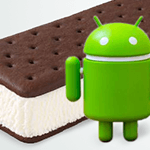
Moving on. In October 2011, Google announces a new version release named Ice Cream Sandwich. Android 4.0 brings updates in the user interface with the new font “Roboto”, soft buttons inherited from Honeycomb, and a built-in photo editor.
This OS version also supports users with new functionality to unlock the phone — biometric sign-in based on face recognition. Another enhancement was the ability to set limits when monitoring data usage.
Android 4.1-4.3 Jelly Bean
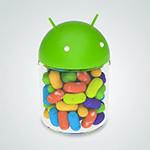
Jelly Bean, launched in July 2012, introduced a smoother UI with significant performance improvements. Among other features, this Android version delivered plenty of new ways to interact with notifications, expanding action buttons. Now users could turn notifications off on an application-specific basis and respond to certain of them within the notification bar.
Android 4.4 KitKat

Android 4.4, called after the famous sweets KitKat, was released in September 2013 and introduced several significant improvements. One of the most essential was the optimization of the OS to run on smartphones with 512 MB of RAM, which enabled more devices to update software to this new version.
KitKat also got a refreshed look and feel with white elements replacing blue ones. Also, it was the first version that received the support of the “Ok, Google” voice command service.
Android 5.0 Lollipop

A year later, in the fall of 2014, Google launched the Android 5.0 Lollipop OS version. It brought new features like Project Volta to improve battery life and Material Design with transitions and animations as well shadows and lighting effects. A newly implemented functionality, Tap and Go, allowed users to migrate data to a new device with NFC and Bluetooth technologies.
Android 6.0 Marshmallow

Unveiled in May 2015, the Marshmallow version was globally released in October, the same year. In essence, Android 6.0 got support for USB-C, native fingerprint reader, and Android Pay that we now know as Google Pay.
Android 7.0 Nougat
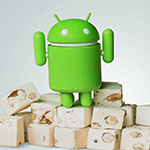
Google’s 2016 Nougat empowered smartphones with split-screen support, so two applications could run on the screen at the same time. It also introduced a customizable pull-down menu, fingerprint swipe-down gesture, and a new set of emojis. However, major enhancements lied behind the scenes and included support for the Vulkan API and a new approach to future updates.
Android 8.0 Oreo

With the release of Android 8.0 Oreo in July 2017, Google introduced some visual changes to the menu. The biggest change, however, was the Project Treble delivery that represented a modular architecture to help hardware vendors keep up with new versions of Android easy and fast.
Android 9.0 Pie

At the end of 2017, the world of smartphones could benefit from the release of Android 9, or Pie, the version that so far remains the most popular. It received a new home button that transformed into one elongated navigation button at the bottom of the screen.
Among performance boost, battery life optimization, and security enhancements, this version included Shush functionality to put your phone into a Do Not Disturb mode when placed the screen down.
Android 10
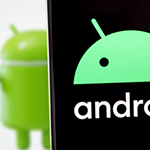
Android 10 became the first version that has left behind iconic names related to desserts. Was it for a change in marketing strategy or lack of well-known sweets, Google decided to name the OS versions using a simple numeric system.
In 2019, this new version got several significant feature improvements, security and privacy updates, a range of new APIs, and support for foldable phones that were about to come.
Android 11
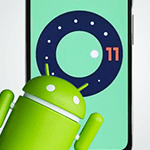
One year later, we could see another version of the operating system — Android 11. It provided more options to adjust notifications and contained upgrades to control smart home devices as the Internet of Things entered our lives, root and branch.
It also introduced some new features like a screen recorder and chat bubbles that flow on top of the other app content and can be expanded or collapsed to facilitate conversations.
Android 12
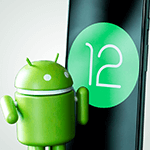
For now, the latest OS version is Android 12 that was released in October 2021. According to Android Developers Blog, it delivers a better user experience, enhanced power efficiency, and easier W-Fi sharing.
Besides other improvements, Android 12 receives a new UI with Material You, an updated design language for a more expressive and personal system.
Android Studio History
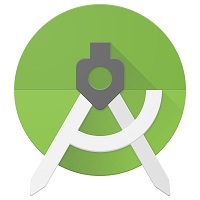
Android Studio is the official Android development tool or, to be more precise, an integrated development environment (IDE) built on IntelliJ IDEA. It was first announced in May 2003 at the Google I/O — the annual developer conference held in Mountain View.
Android Studio supports various programming languages like Java, Kotlin, C++, or Go to provide vast opportunities for building applications for every type of Android device.
The software includes code editing, debugging, and performance tools. Developers can also take advantage of such features as a visual layout editor, APK analyzer, fast emulator, or real-time profilers. Android Studio was designed to help you create high-quality apps, streamlining the entire development process.
Future of Android
With all that history behind it, Android remains the position of a leading operating system with a 73% market share. Shifting its focus on supporting emerging technologies and increasing the reach of Android applications, Google now is actively integrating AI, Machine Learning, and IoT tech in its products.
On top of that, Google keeps working on its new OS Fuchsia, that’s designed primarily to power smart homes and IoT devices but can also support smartphones and tablets. It means that one day we might see Fuchsia replacing Android OS. However, as far as we now know, Google’s plans for Fuchsia are quite vague.
Final Thoughts
Android has achieved a lot over the course of the past 15 years. Because of all the developments with this platform, we need to study Android’s history to better understand the modern principles of Android software development.
Hopefully, you can use this information to get inspired and approach your next Android app project idea. If you’re looking for a trusted software development partner, the Velvetech team is ready to support you. Leverage our expertise; contact us today.
Frequently Asked Questions
Android Inc. was founded in 2003 by Rich Miner, Nick Sears, Chris White, and Andy Rubin.
Probably, we can name YouTube or Maps being the first Android applications as they were pre-installed.
The same people who founded the company — Rich Miner, Nick Sears, and Andy Rubin.
The company is now owned by Google that bought it back in 2005 and helped foster the Android operating system.









